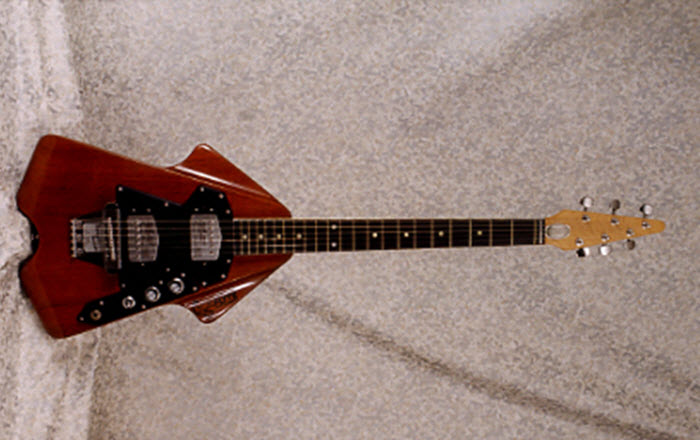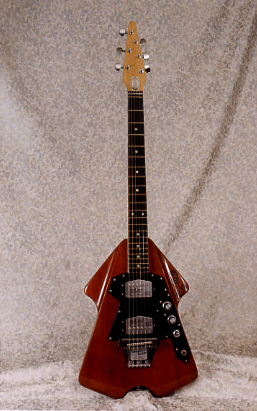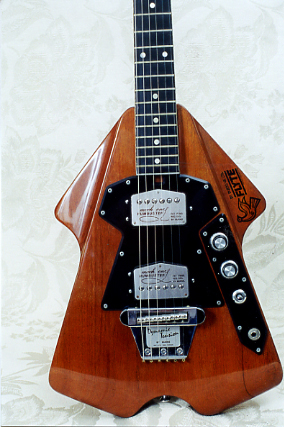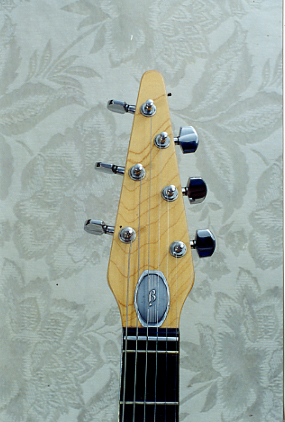
Last week I opined about my penchant for unusual, not to say, ugly guitars like the Fenton-Weill Tux-master from England. Now, I don’t mean to throw (rolling) stones—the States has produced its share of butt-ugly guitars—but Merry Old England has contributed mightily to the cause. And even though he’s revered in the U.K. as their very own Leo Fender, Jim Burns has had a hand in more than a few guitar models that might crack a mirror if they could see themselves. One case in point: the Burns Flyte.

Vintage 1976 Burns Flyte Electric Guitar
Now, the Burns Flyte is definitely a step up from the Tux-master, but not such a very big one. James Ormston Burns (1925-1998) began designing guitars in around 1958 when he made a short scale Supersound guitar for the musician Ike Isaacs. In 1959 Burns teamed up with Henry Weill to form the Burns-Weill company, producing the rather ungainly forebears of last month’s featured Tux-master. Burns and Weills apparently weren’t a match made in heaven and they had parted ways before the year was out. In 1960 Burns struck out on his own, founding Burns London Ltd. And putting out what’s now a legendary line of soldibody electric guitars.
Probably the most famous feature on Burns guitars of the 1960s was the setting called “Wild Dog” on the Bison and some other models. I can remember not being able to wait to plug in mine when I got it. Wild Dog!! A snarl? Growl? Sharp bark? Imagine my disappointment when I learned that Wild Dog was simply a somewhat weak phase-reversal effect like you get in-between pickups on a Strat! Now there was the marketing department run amok!
Burns guitars quickly won the hearts of British guitar players…there were, indeed, few other quality options. Plus, they arrived at just about the time that teenagers were trading in their Skiffle washboards for their first electric guitars in order to play that new music from the Colonies.

Vintage 1976 Burns Flyte Electric Guitar
Meanwhile, in the former Colonies, guitars—especially electrics—had become hot commodities among the young. And there were lots of young folks, the Post-War Baby Boomers, hitting the right age to become a “market.” Savvy businessmen wanted in on the gold mine. Companies as diverse as Norlin (a brewing conglomerate) and CBS (TV, movies, and records) started buying guitar companies (Gibson and Fender, respectively).
Into the corporate feeding frenzy jumped the Baldwin Piano and Organ Company. At least it was in the musical instrument business to begin with! Initially Baldwin was a bidder for Fender, but lost out to CBS. On the rebound, Baldwin set its eyes on Burns of London and in 1965 began importing Baldwin-badged versions of Jim Burns’ guitars.
However, Baldwin’s affair with Burns was relatively short-lived. In 1966 Baldwin struck a deal to purchase Gretsch and they proved to be much better sellers in the U.S. marketplace. Baldwin held on to the Burns property until closing it down in 1970.

Vintage 1976 Burns Flyte Electric Guitar
Burns wasn’t through with guitars yet. From 1969 to 1973 Burns manufactured Hayman guitars for the music distributor Dallas-Arbiter. As part of the agreement, Jim Burns couldn’t use the Burns of London name, but somehow Burns UK was acceptable and Burns resumed making guitar in Newcastle upon Tyne in 1974. Which brings us to the Flyte.
The Flyte—originally supposed to be the Concorde (or Conchorde)—coincided with the debut of supersonic aviation. Hence the swept-wing appearance. If you appreciated weird guitarflesh, this should tickle your fancy. I keep looking at it it just keeps getting weirder, and in an especially good way! Those pickups are called Mach One Humbusters. The Dynamic Tension bridge is pretty interesting…well, no, it’s not. It’s just weird. Indeed, much like Hayman guitars before it, Flytes were well made and pretty unremarkable except for the eccentric appearance.

Vintage 1976 Burns Flyte Electric Guitar
Apparently, Burns UK Flytes were played by so-called Glam Rockers like the band Slade and Mark Bolan (who made a career of eccentric guitars, among other things). Wikipedia lists other Flyte players, but I’ve never heard of any of them, not that that signifies anything. But, you have to stretch to find Flyte fans; they never did take off.
This guitar is #172. I have no idea how many Flytes were produced, but I suspect production quantities were not enormous. They were only made for about 2 years. In around 1977 Burns UK introduced the Mirage to replace the Flyte, with re-designed Mach Two pickups. Burns UK then bit the dust.
Jim Burns gave guitars one more go with the oddly named enterprise “Jim Burns Actualizers Ltd.” From 1979-83, but that met with even less success than Burns UK and the Flyte.
Still, you have to give Burns high marks for chutzpah and if your taste, like mine, runs to the unusual, you should be sure to catch a Flyte the next time one come your way!

I like the headstock, the shape of the pickups, and the bridge looks decent in low-res. The body? Ewwww… No, thank you.
I actually kind of like the looks of the guitar. It’s futuristic and traditional in one stroke. I think surrealistic is a good description. There is something almost seventy-ish Gibson about this guitar in some respects, referring to some of the visual elements that a few axes that Gibson turned out in the early to middle years of that decade. I might see if I can score one of these at a reasonable price. I can’t imagine that it sounds hideous, but perhaps different.
This body shape lived-on in a way in the Switch Vibracell “Futura / Revolution” models. See these pics: http://www.mikelombardi.net/guitar/fireo.jpg and https://reverb-res.cloudinary.com/image/upload/a_exif,c_limit,f_auto,fl_progressive,h_620,q_75,w_620/v1428132543/u902ul3wgzhuvj4jwygn.jpg
LONG LIVE THE FLYTE
The Burns Flyte was the first guitar I lusted after in the mid 70s and contrary to the opinion of others, I think the shape and styling are very beautiful and highly innovative for that time. If you hold one up above you almost horizontally, you can see the headstock has a droop nose effect exactly like Concorde! I am currently rebuilding one that had been brutally butchered over the decades, and it will be my take on the original – some restyling to conceal the butchery that had taken place, and a few modern features such as a built in tuner (the N-tune), luminescent side dot markers on the neck, some pretty potent toaster style humbuckers , a kill switch and an original Concorde metal Decal on the headstock as given to Air France Crew members back in the day 🙂
I can’t wait to get it finished… just waiting for the new finish (high gloss silver) to harden before final polishing and assembly.
Phoenix-like my Flyte will arise once more…
I bought one of these a while back, but the frets were like a ploughed field, the neck concave, the metal binding half gone and the truss rod seized. I recently acquired a new neck (un-used ex-factory genuine). Imagine my surprise on removing the old neck to find a chunk of cardboard packing it out below the body end fixing screws, so the neck tilted back miles. I’ve lowered the bridge, the pick ups as much as possible, but this still will not work. Has anyone else experienced this? Was it a design flaw with the “Dynamic Tension” bridge thingy?
back in 1976 I was playing in a rock band in Cambridge (I was actually in the Royal Air Force at the time) and I was a regular customer at Ray Smith’s Music in Norwich. I bought a beautiful Peppermint sunburst Burns Flyte 6 bearing the serial number 001. However I only owned the Guitar for a few weeks before it was stolen. It resurfaced in the mid 1980’s in an advert in the “Exchange & Mart” it was for sale in a music shop in Swansea. I immediately called the shop and arranged to travel from Lincoln to Swansea. I told the shop that I had proof that the guitar was mine and had been reported stolen in 1976. When I got to the shop the guy said “Sorry Mate I just sold it for cash” back then you never had to prove sales I have never seen it surface since then. To be quite honest it played like a dog and the pickups were crap. BUT it was the coolest guitar you could get back then
Hello Simon B and Johnno.
I am doing some research for a Museum Exhibition at Auckland Museum.
I need to locate a white Flyte guitar
The exhibit is in New Zealand.
Could I give either of you a call ?
My email address piecartrockandroll@gmail.com
I can let you know more details
JB
Hi guys.
I have a Flyte similar to the one in the photo – but with a maple neck and it is a fantastic guitar. I have owned it since 1977.. No other guitar plays anything like it. I even have an angry note in the case from Jim Burns to the previous owner and informing him that there is nothing wrong with the intonation, it is simply rusty old strings that were causing the problem. If anyone wants any info on the guitar, feel free to contact me on : john.fannon@yahoo.co.uk
I have a real soft spot for this special guitar – if you get the chance of one, snap it up !
When i was very young and had caliper on my bad leg I used to hang about in the Burns UK factory located at the back of Westoe Rd near the bottom of Roberts St South Shields where my great grandmother lived, my late father would be soldering up the Burns Flyte guitars on his own solder station (they didnt have one at the time?)I had a Flyte built up with unfinished reject parts and yes it had cardboard under the heel to bring the neck up, that guitar was unplayable and no good for learning and playing sitting down so was traded in to a second hand shop for two old acoustics which were much better for my needs at the time, very fond memories of Jim Burns and the the guy who was spraying the bodies who took the time to explain to me what he was doing. Many years later while working as the relief manager of the Stags Head pub in South Shields I was loaned a real Burns Flyte by Mr Michael Minchella a musician from a well known ice cream manufacturing family in the town and I still found it a dog of a guitar to play. Glad to see they still have some interest and a very healthy collectable price!
I had this beauty in silver from 84 till 97 and still regret bitterly that I have given it away. Forget the design or shape, this gat is a player. For such a low weight guitar a great sound, the humbusters worked perfectly and action and playing ability was superb. I owe every guitar, musicians are dreaming off because I can afford it but this little Burns has its place in the front row ( if it still would be with me)
I remember the final closing down auction at the Burns workshop in Washington (just south of Newcastle-upon-Tyne). Most of the parts needed to make a Burns Flyte guitar (i.e. body, neck, pickups, machine heads, custom bag, etc.) were sold off, bag by bag. I paid £15 for my bag. I took the bag to a Newcastle guitar shop and asked them to put it all together for me, using Gibson parts where parts were missing (i.e. switches, bridge, some electronics). That cost about £30. So the entire guitar cost me about £45 all in. And it was absolutely beautiful. That guitar followed me all over the country and, during a brief period of poverty, I reluctantly sold it on eBay for about £450. How I wish I still had it. But I’ve held off on replacing it with another. I think it was the combination of Burns and Gibson parts, all put together by someone with a love for electronics, that made it sound so good. I often wonder what it’s doing now.
I still have a few burns flyde original unused spares…if anyone is really interested.
Hi jveti,
I’d be interested to have a list of Flyte spares you have.
Gotta love Jim Burns. Certainly a unique talent.
Thanks
J
Hi, any news on those Flyte parts at all?
Thanks
J
you can email me at… jamiestovell@tiscali.co.uk
thx
J
Hello Jveti,
Do you have a black scratchplate for a Burns Flyte ?
Also – what other spares do you have please ?
John
i have just rediscovered someones holy grail whilst exploring my loft… stored for 40 years in the dry…
Unused unplayed BURNS FLYDE BASS.. bare body and neck. I know I bought it with plans I never got around to in the late 1970s Burns factory closure sale…
Might be tempted to sell for a decent price now.Can supply photos to serious enquries.. postcode SR67SG
I bought one from a guitar shop in Bradford in the early nineties. It was and still is a little battered! It’s missing the metal plate for one the humbuster pickups and a little bit of the Flyte logo. I have a feeling it may be a prototype as it is slightly different to every other picture I’ve seen of them, but only slightly.
Hi James Veti,
You don’t have a cover for the pickups do you?
Thanks
I,m looking for a good burns flyte guitar I used to have a beer with Jim in the County in South Shields where he brought the flyte prototype and asked me how it was It was fab and so was he Feel like its part of my history need one to close my circle Cab you help ?